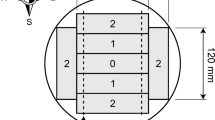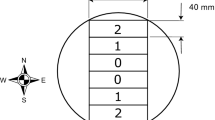Abstract
A mill study of 62 trees, in which boards were reassembled into their original logs, permitted the construction of wood quality maps. In this instance stiffness profiles were obtained from butt to upper-top logs, based on machine stress grading of all boards and then averaging values from the 62 trees. Traditionally the butt log has been perceived to be the most valuable log in a tree, because it is bigger and gives a higher recovery of lumber. However, it is shown to contain a wide cone of very low stiffness wood that is confined to the first 2.4–2.7 m above ground level. Above this point stiffness gradients become cylindrical with no noticeable decrease in stiffness up the tree stem. Stiffness in all logs increased radially from pith to cambium with the greatest change being associated with the wood nearest the pith. The low stiffness at the base of the tree suggests that an alternative log bucking strategy should be considered, namely cutting a short 2.4–2.7 m butt log for plywood/LVL or for bolter sawing and only cutting standard length logs above this point.
The least stiff logs (lowest 20%) yielded lumber that had an average stiffness that was over 1 GPa less than the average for the population. A case can be made for separating these logs and processing them differently.






Similar content being viewed by others
References
Andrews M (2000) Where are we with sonics? Wood Technology Workshop 2000, University of Canterbury, pp 57–61
Buchanan AH, Nakada R, Walker JCF (1999) Log segregation by stiffness class. In: 3rd Wood Qual Symp: Emerging technologies for wood processing, Rotorua, New Zealand and Melbourne, Australia, FIEA
Dickson RL, Raymond CA, Joe B, Wilkinson CA (2000) Segregation of Eucalyptus dunnii logs using acoustics. Wood Technology Workshop 2000, University of Canterbury, pp 46–56
Fewell AR (1984) Timber stress grading machines. Building Res Establishment Info Paper, Garston, UK 17:84
Gaunt DJ (1999) Performance grading of lumber and the development of the “E-Grader”. In: 3rd Wood Qual Symp: Emerging technologies for wood processing, Rotorua, New Zealand and Melbourne, Australia, FIEA
Hirakawa Y, Fujisawa Y (1996) The S2 microfibril angle variations in the vertical direction of latewood tracheids in sugi trees. Mokuzai Gakkaishi 42:107–14 (in Japanese)
Nylinder P (1958) Aspects of quality production, Part 2. Skogen 45(23):714,717,718 (in Swedish)
Perstorper M (1996) Lengthwise variation in grading parameters and comparison with bending strength tests. In: Sandoz JL (ed) Proc 10th Int Symp Nondestructive Testing of Wood, Lausanne, Presses Polytechniques et Universitaires Romandes, Lausanne, pp 341–50
Timell TE (1986) Compression wood in gymnosperms, vol. 1–3, Springer, Berlin Heidelberg New York
Von Wedel KW, Zobel BJ, Shelbourne CJA (1968) Prevalence and effects of knots in young loblolly pine. For Prod J 18(9):97–103
Xu Ping (2000) The mechanical properties and stability of radiata pine structural timber. Dissertation, University of Canterbury, New Zealand
Author information
Authors and Affiliations
Corresponding author
Rights and permissions
About this article
Cite this article
Xu, P., Walker, J.C.F. Stiffness gradients in radiata pine trees. Wood Sci Technol 38, 1–9 (2004). https://doi.org/10.1007/s00226-003-0188-2
Received:
Published:
Issue Date:
DOI: https://doi.org/10.1007/s00226-003-0188-2




